
|
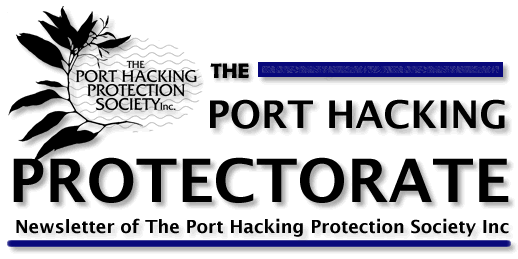 |
August 1995 |
|
Editorial |
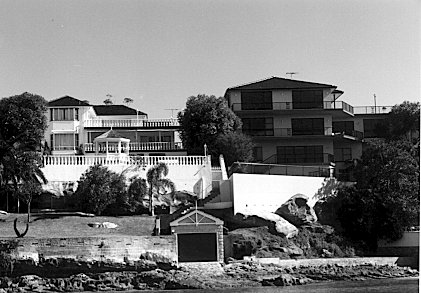 |
Foreshore Development
The major impact on the Port Hacking waterway over the last century has been urban development. On the north shore of the Port, very little land remains in the form of parks or bushland reserves. On the south shore, predominantly because of the existence of the Royal National Park, only the communities of Bundeena and Maianbar interrupt the bushland aspect.
The foreshores of Port Hacking have been under the same pressures for development as have other parts of Sydney. Population in the Sutherland Shire has almost doubled in the past fifty years and is projected to increase by another ten thousand in the next ten years (to 204,000). In conjunction with increased population and, therefore, more demand for housing, there is an increased demand for larger homes.
Further pressure on the foreshores of Port Hacking is also being placed by the developments in the Shire to increase its attractiveness to tourists. Sutherland Shire Council has been active for some time in planning for measures to capitalise on the Shire's extensive waterfront areas - on the Port Hacking, this means predominantly the Royal National Park and the beaches of Cronulla.
Urban-based development, whether tourism, commercial or residential has three major impacts on Port Hacking:
-
It changes the character of the visual aspect of foreshores. Bushland is cleared from the land to make way for housing structures, areas are excavated or built up to make the blocks more suitable for building. On the north shore of the Port, it is predominantly the houses themselves that define the character of the foreshore.
-
It changes the accessibility of the foreshores for those who may want to enjoy the waterway. Fifty years ago it was possible to walk around Gunnamatta Bay (and it was heralded as a "beautiful bay in which to swim, fish and enjoy boating"). Now the experience is marred by having to negotiate marinas and boatsheds, retaining walls, stormwater outlets, and muddly silt.
-
It changes the character of water runoff into the Port. Water quality was a major feature of the last issue of the Protectorate (No. 8). Pollutants in the water reaching Port Hacking is only one aspect of the changed character of water into the Port. More houses and landscaped areas around houses and more tarred and guttered streets to cater for increased numbers of houses means more surface runoff. The soil and vegetation which used to retain and filter rainwater has substantially disappeared.
|
| At some point, ad hoc, small scale developments, each one making no significant impact, total to a reduction in the pleasure of foreshore use for residents and visitors alike. |
|
Over the past ten years, the move to gain control over the negative impacts of urban-based development has been gaining increased momentum. Significant among those seeking to halt and prevent negative impacts has been the Sutherland Shire Council.
The Current Issues
Council has significantly strengthened its Environmental Services Division. That Division now provides a major input into resource allocation decisions. The past two years have seen an integrated approach to water quality management. Studies have been undertaken to check quality of urban runoff throughout the Shire (a summary of that study for Port Hacking is included in this issue of the Protectorate). An active program of community education has also begun with regular newsbriefs through local papers and disbursement of information on water quality and sources of pollution. Many drains and channels in the Shire now have signs or stencils on them to tell people where and into which waterway fluids and litter entering the drain will end up. In addition, pollutant traps are being installed in those areasidentified as stormwater sources of pollution. These traps range from gross pollutant traps (such as that installed at Burraneer Bay Road capable of holding 50 tonnes (wet) of rubbish and silt) to the one featured in this issue of the Protectorate , the CDS unit, to construction of wetlands (such as the one in the RNP also featured in this issue.
Other Authorities, such as the Water Board (with its various Environmental Enquiries and activities reported on in previous issues of the Protectorate, the EPA (including the HRCMC) and CALM have also been active in working towards an infrastructure which reduces the adverse impact of the built environment on the waterway itself.
While attention on water quality and infrastructure issues appear to be achieving positive results, the same cannot be said of the management of the built environment itself (houses). In 1990, Sutherland Shire Council called for submissions on the revision of the Foreshore Development Code of Sutherland Shire. PHPS (along with one other individual!) responded to this call. A summary of that submission is in this issue. A modified Foreshore Development Code was reissued. But it would appear that in the process of reviewing the code, Council also decided to amend its Local Environment Plan with regard to permissive occupancies between the mean highwater mark and the foreshore building line. Council, in its amendment, insisted that before applications for development or extensions to foreshore homes would be considered, unapproved structures between the mean highwater mark and the foreshore building line must first be demolished.
This move by Council spawned the reaction of a number of foreshore owners who formed themselves into the Sutherland Shire Waterfront Owners Association. This group has waged a vigorous and active campaign to have this part of the LEP removed or amended.
Sutherland Shire Council put forward a further draft Development Control Plan for Waterfront Properties. However, the sticking point of this Control Plan was again the requirement for the removal of existing illegal structures with many waterfront owners believing that such a requirement was an infringement on their private property rights. The effectiveness of the current Code was called into question in June this year when its requirement for demolition was waived in a specific case (Leader 8/6/95). |
| In the battle for individual rights of property owners and developers, the need for appropriate development of the foreshore appears to be lost |
|
Development of a meaningful Foreshore Development Code for Port Hacking, however, cannot be discussed without considering the wider community debate, discussion, battle, over dual occupancy and medium density. Sutherland Shire Council has fought a protracted battle with the former State Government over the right of Council to ensure that development within the Shire preserved the character of the Shire. In addition, two other groups have been vocal in this debate: The Sutherland Shire Waterfront and Foreshore Owners Association (SSFOA) and the Combined Residents/Precincts of Sutherland Shires (CROSS). SSFOA together with the HIA, the MBA, Cronulla Sutherland Division Real Estate Institute of NSW and the Practicing Architects of Sutherland Shire have objected that the LEP is unfair (Leader, 14/3/95). CROSS, also representing residents throughout the Shire, claim that the campaign waged by SSFOA is short-sighted and misleading.
In all this furore, which still continues though somewhat abated since the election of the Labor Government with its ban on subdivision of dual occupancies, the need for appropriate development of the foreshore appears to be lost. Keith Muir in this issue of the Protectorate, makes a plea for consideration of the overall impact of decisions and for the need to support those groups of hardworking volunteers who give up their free time and energy to ensure that the silent environment (which we all like to enjoy) is cared for. Architect A. D. Oosthuizen writes that low impact development which caters to the needs and aspirations of home builders is possible, and house builders should insist upon competent design of their homes. Environmental Damage from Building Sites
Erosion from building sites results in deposits of sediments and shallowing of water at the heads of bays of Port Hacking. The Hacking River Catchment Management Committee (HRCMC) has highlighted the effects of erosion, which results in deposits of sediment and shallowing water at the heads of bays.
This is occurring at the head of Yowie Bay, Burraneer Bay, North West Arm and the upper reaches of the Hacking River itself. Sedimentation restricts navigation, reduces water clarity and may smother seagrass beds leading to depletion of stocks of fish and invertebrates.
HRCMC Chairman Peter Wells said: "It is a disgrace that building sites are having such an adverse effect on the environment".
Mr Wells said: "It is up to everyone to act in an environmentally responsible manner. The community has to speak up and say that current building practices are unacceptable, the Council has to ensure compliance with site controls for sediments, and land owners and builders have to lift their game".
Councils require plans for sediment controls to be used with each building site, but some plans are not fully implemented. Also, many builders do not maintain sediment controls in working order, and there has not been sufficiently frequent enforcement of sediment controls.
Council officers will soon be authorised to hand out fines of $600 under the Clean Water Act, with much higher fines for continued non-compliance.
Mr Wells said "While we recognise that there are often site problems making it difficult for builders to fully comply with sediment control plans, there is still significant scope for improvement. The critical issues on a building site are what sediment controls are left in place at the end of the day, and how the site has been left during a storm". |
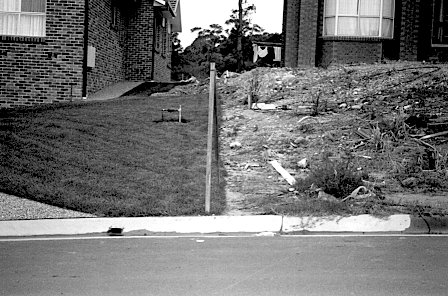 |
"If a storm struck today, most building sites in Sutherland Shire and Helensburgh area would lose a great deal of sediment. Although each site may not contribute much sediment, together they can be a terrible load on the waterways of the Hacking catchment. Builders who don't do the right thing with bare soil on their sites leave themselves open to be fined. The community should not have to put up with this environmental degradation".
The HRCMC is also concerned about sediment loss after building is finished, where bare earth is often left unturfed or sediment controls are taken away too early by either the builder or the householder.
"We simply want to improve the environment in the Hacking River catchment and we are asking Builders, Councils and the community to help".
The HRCMC has representatives from State and Local Government with a majority of community members. It acts to coordinate government and the community to improve the catchment of the Hacking River.
If builders want to know more about sediment control, they should contact Sutherland or Wollongong Council or a building consultant with knowledge of sediment controls. Ideally, at least one person on a building site should have done a one day course on sediment controls conducted by either the Department of Land & Water Conservation or a building consultant. Stop Press
Innovative new Pollution Device to Clean Camelia Gardens Sutherland Shire Council recently signed a contract for the installation of an all Australian designed Pollutec CDS (Continuous Deflective Separation) unit to prevent stormwater borne pollutants from reaching the world famous Camellia Gardens at Caringbah and Yowie Bay. The CDS technology will capture almost 100% of all stormwater borne litter down to the size of a match head, together with a large proportion of smaller particles, sands and silts . Installation is to be commenced mid September. The unit is mostly underground and will therefore be visually unobtrusive." |
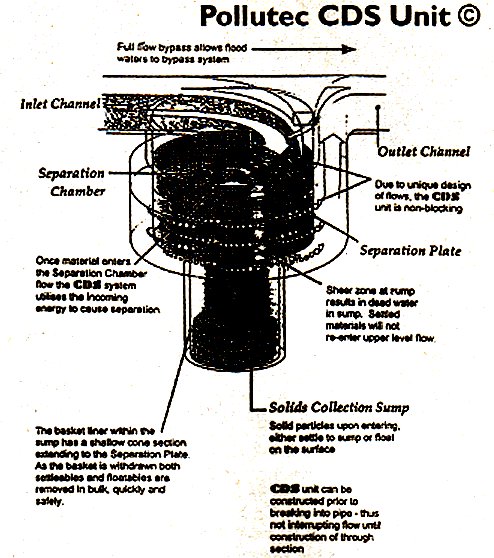 |
Gross Pollutant Trap and Wetland in the RNP
A gross Pollutant Trap and artificial Wetland is to be constructed opposite the eastern end of Engadine Avenue, Engadine to imrove the quality of stormwater from the surrounding catchment entering the Royal National Park and the Hacking River. The wetland will help absorb heavy metals and also help prevent weed outbreaks caused by the flow of nutrients. |
 |
Construction of the wetland will cost a total of $170,000 of which $33,000 is provided by the Department of Conservation and Land Management. The wetland itself will be located within the Royal National Park. It will be a marsh growing a range of macrophytes such as reeds and bulrushes.
Results from a study on Urban Runoff in the Hacking River Catchment
- conducted by Sutherland Shire Council |
Site and site characteristic |
Results of study - higher than recommended levels of: |
| North Cronulla Beach - commercial/residential* |
acidity, faecal coliforms, faecal streptococci, total nitrogen, TKN, copper, lead, zinc |
| Cronulla Beach - Commercial* |
acidity, faecal coliforms, TKN |
| Shelley Beach - Residential* |
faecal streptococci |
| Gunnamatta Bay - Residential/Commercial Landfill, sewer overflow* |
faecal coliforms, total nitrogen, TKN, nitrate |
| Burraneer Bay - Residential |
acidity |
| Dolans Bay - Residential, Yowie Bay East - Residential, Gymea Bay - Residential, Kangaroo Creek - Commercial/Residential |
. |
| Yowie Bay West - Commercial/Residential - Westfields - downstream of trash rack |
lead |
| North West Arm - Residential |
suspended solids, copper |
| Hacking River - Forested National Park/Residential - Helensburgh |
. |
| Bundeena Creek - Unsewered residential (algal problems) |
faecal streptococci |
| Engadine Creek (Engadine Ave) - residential - discharges into RNP - future wetland site |
oil and grease, total nitrogen, zinc, nitrate |
| *Previous studies identified a water quality problem |
|
High levels of suspended solids can originate from land clearing during subdivision construction, building sites, landscape works, pumpout of pits after rain, or erosion. Sendimentation from these sources may be the most damaging of all human impacts on Australian streams due to the fact that almost all other pollutants bind to, and are transported by, sediment particles.
Faecal Coliforms, whilst themselves not disease-causing, are indicators of the possible presence of other bacteria that are. Their presence indicate recent sewage contamination. Levels of faecal coliforms were "too many to count" on four occasions at the Cronulla drain and on three occasions in Gunnamatta Bay.
The Faecal Streptococci organism is generally used as an indicator of contamination by animal faecal material. However, the streptococci organisms live longer than faecal coliforms and so their presence may also indicate a previous pollution incident.
Oil and grease arise from diverse sources including road surfaces and pavements of petrol stations as a component in lubricant, fuel spillages, hydraulic fluids and coolants, and other petroleum products, as well as cooking and food processing establishments.
Total Nitrogen is introduced to the system through decaying organic material, sewage, fertilisers and rainwater.
TKN is a measure of the non-bioavailable nitrogen in the Total Nitrogen measure.
Copper is an industrial water but also arises from domestic sources, including piping and motor vehicles. copper is a common pollutant of boating facilities. The element is not particularly toxic to animals but is toxic to plants at moderate levels.
The major sources of Lead are motor vehicle emissions, industry paint and plumbing.
Zinc is a by-product of metal-plating industries and is a common industrial pollutant. It is also a major component of sewage sludge, and of road runoff through tyre abrasion. Domestic sources include galvanised roof and guttering, particularly garden sheds.
One of the worst sites tested was North Cronulla Beach. It experiences high loadings of nutrients and metals and appears to contain a sewer overflow leak. Also a bad site was Cronulla Beach. There is suggestion of a sewer overflow or sewer pipe burst at this location. Further sampling is continuing to see whether recent works at this site have alleviated the sewage problem. The high numbers of faecal streptococci unaccompanied by high faecal coliforms suggest either an animal waste problem or an aged sewage source. At Gunnamatta Bay, there is a suggestion of regular sewer overflows. Surprisingly high levels of Total Suspended Solids and Copper were found at North West Arm and more investigation is needed to find the source.
The source of this information is Attachment 1 of Sutherland Shire Council Papers (EHC496-95) of 13 June 1995. The case for boat ramp at Bonnie Vale
Brian Page - Bundeena Maianbar Water Access Association The Bundeena Maianbar Water Access Association was distressed to read of claims by PHPS that our Association, or elements therein, had called PHPS "bloody minded greenies" (Protectorate, issue 8). Whilst differing on some points of view regarding the boatramp proposal, both PHPS and BMWAA have until now maintained a sense of fairness and dignity in all discussions.
Members of BMWAA are practical "greenies". Yes, we want a boat ramp, but there are many green advantages to our proposal. There is a saving in fossil fuel in not having to tow a boat some 70km to and from our nearest ramp. There is the fuel saved in not having to motor a boat the length of the river to reach the open sea. Trailer boats do not use antifouling. Visual pollution, depending on one's point of view, is minimised in the more congested upper reaches of the river. The possibility of bank erosion to the more sensitive upper reaches is also minimised. What of the time and money wasted in travelling to our nearest ramp!
Nobody had to fight us to have an EIS on the ramp proposal. We want it to be a healthy decision for all the right considerations, but we want it to be the best deal that can be provided for our community. We believe kids to be better off sailing or fishing on our waterway than sneaking through the Park on trail bikes. We believe in "life be in it".
Bonnie Vale picnic area is a recreational area and has been for many decades, it is not untouched bushland. Once formally part of Bundeena, it is land mostly devoid of native flora and fauna. It has been retained and filled with hundreds of tonnes of rock and soil. The area has been extensively used for recreational boating in the past as well as swimming, fishing and picnicking. We fail to understand why the National Parks Association argues so hard against this proposal when a boatramp at Bonnie Vale is a positive asset to the area and allows people access to the waters of Port hacking. Do the same opponents of the ramp drive their fossil fuelled motor cars over tarred roads built through the same National Park, so that they too can enjoy the beauty of the Park? Our Association certainly does not deny them the opportunity to do just that.
The Plan of Management for the Royal National Park will be released later this year and one hopes that it signals the start of a new era in the management of Bonnie Vale. Tourists to a recreational picnic area expect clean facilities, more shade trees, well defined and maintained roads and tracks, adequate barbeques and fuel, a well laid out camping ground and in this case, a low impact, low key boat ramp.
The Royal National Park is one of the "jewels" of Sydney. It is here for the people to use. The Park deserves better and so do the people. Keeping the Ports Foreshores Forever Green
Keith Muir - Total Environment Centre
Conservation always comes back to a collective responsibility to protect the environment for the good of the community and the planet.
Just about every Australian accepts the limits on individual freedoms when, say, driving a car on a public road. The same isn't true when it comes to retaining trees on private land.
Sadly, conservation of foreshore lands is still seen by some as a radical and unfair imposition on individual freedoms by "greenie do-gooders". It is this mind-set that had dogged the conservationists and Sutherland Council's best efforts at tree preservation and improvement of public access to the Port.
Long term residents living on foreshore properties have seen their amenity disappear through increased boating activities and attendant noise pollution, and through the 'uglification' of the Port's foreshores as swimming pools, dual occupancies, boatsheds and marinas and the reduction of numbers of Angophoras (the arboreal emblem of the Shire) are imposed on the landscape. Foreshore houses are getting bigger and there are more of them each year!
Most bushland around the Port's northern foreshores is in private hands. Planning provisions can be drafted to give priority to retaining bushland.
The foreshores can be preserved by preventing further residential development of any kind in the visual catchment of Port Hacking. |
| Conservation measures are the price we pay for a livable environment, just as taxes are the price for civilisation. |
|
Conservationists and residents must be prepared to defend the environment and challenge the paradigm that every home owner has a right to build a big structure covering nearly all of the block. The good intentions of Development Control Plans, Local Environmental Plans and the Port Hacking Management Plan must be given real teeth. Further alienation of foreshore lands can be stopped by preventing further issue of leases of boathouses. Open spaces on the foreshore should be set aside for family-based passive recreation. Existing open spaces can be linked by foreshore walks.
Reader, if you want to keep the trees along the Port's foreshores, if you want your children to join the sea scouts and enjoy the Port without fear that they will be run over by a speedboat, or jet ski or get hepatitis by swimming in it, then call on Sutherland Council to introduce effective regulations that will limit loss of trees, prevent overbuilding, stop tasteless development, prevent marinas and boat houses being built. There is no doubt that the collective skills of the current Council can deliver any level of conservation you want. But the Council won't substantially act unless you make it act.
Conservation groups are active on a number of fronts to safeguard the environment we live in. Through the existence of the No Third Runway campaign, we don't have jets flying all night. Through the existence of the Manly Environment Centre and Dr Peter Macdonald the Water Board and Government is finally looking at alternative methods of sewerage treatment rather than more ocean outfalls. One of the most effective groups safeguarding conservation issues in the Sutherland Shire has been the Sutherland Environment Centre.
If you are serious about preserving and beautifying Port Hacking, consider making a tax deductable donation to Sutherland Environment Centre, PO Box 589, SUTHERLAND NSW 2232. The Importance of Arcitectual Design on the visual impact of the built environment on the foreshore
A D Oosthuizen - Bundeena
I recently overheard a conversation between two families of European tourists on the ferry to Bundeena. They were enthralled by the water quality of Port Hacking and the natural beauty of the Royal National Park. But they were appalled at the dense ugliness of unimaginative houses protruding in the front of the tree line on the foreshore.
When considering the protection of Port Hacking we admirably consider pollution, water quality, siltation, flora and fauna and marine life. However, we tend to avoid considering the visual impact of our houses on the beauty and value of the Port.
We live on the waterway because of its beauty but we spoil it by lining it with insensitive and unimaginative buildings. Why is this so?
One reason is the overt and covert restrictions imposed by Councils. While well intentioned, Council Codes are generalised, referring to the average site. As we well know, foreshore sites are mostly anything but average. Foreshore sites are usually steep slopes to the water and, around Port Hacking, mostly south facing. To make a house work on the foreshore requires innovative design and construction. Yet Council Codes enforce construction methods that are out of date, add tens of thousands to the cost of building, obliterate the site, are energy inefficient and often ugly.
Predominantly, however, I believe that the reason for the mediocrity of our buildings, is because many builders of homes are not aware of the importance of design. By design I mean resolving the complex interrelationships between site conditions, internal and external climate control, privacy, various construction methods, spacial relationships, proportion, scale, aesthetics, etc. Only by competent design can we prevent our houses from being ice boxes in winter and saunas in summer. Only by competent design can we maintain the views yet provide privacy, reduce construction impact and cost, rediscover simplicity, proportion and elegance, and, above all, stop building houses and make homes instead. Through good design we can make our homes energy efficient, environmentally sensitive, cost effective, comfortable, functional and beautiful. Through design, we can increase the value of our homes over and above mere bricks and mortar. Through design we can make the foreshore built environment as beautiful and sensitive as the natural environment of Port Hacking.
Yet it would appear that competent design is very little valued. It is seen by the vast majority (98%) of home builders and building contractors as an unnecessary expense. Yes, design is an added initial cost to the home, but it does add to the pleasure of living in the home, reduces ongoing expenses of living in the home and adds to its resale value.
Our natural environment reflects our heritage bestowed by the land and sea. Our built environment reflects us and our relationship to our heritage. At the moment, judging by the tourist conversation mentioned earlier, it appears we lack the sensitivity necessary to create beautiful buildings. I hope we can improve the design of our building so that when I overhear our Olympic guests in 2000, they will compliment our built environment equally with our beautiful natural environment. Bush Regeneration -
Helps Clean Port Hacking
R Rogers - Bushcare Officer, Sutherland Shire Council |
 |
A necessary element of modern society is urban development. But, over the course of 200 years of such urban development we have wreaked considerable and irreparable damage to natural ecosystems. These are the same natural ecosystems which play a vital part in maintaining the quality of water and air, provide habitats for animals and plants and provide us with a bushland environment in which to recreate.
What destroys the bushland around urban areas?
The most obvious destroyers are:
- Increased urban runoff caused by greater areas of impervious surfaces - roads, concrete driveways, cemented areas, etc.;
- Erosion and siltation from land clearing for roads, housing estates, electricity, water/sewer and telephone services;
- Rubbish dumping consisting of lawn clipping and garden refuse;
- Plastic bottles and bags, glass and tins, animal faeces, fertilisers, detergents and heavy metals.
A large proportion of the above matter enter bushland via the drainage system, destroying native flora by either choking growth under silt or rubbish, or pouring into the soil ruinous nutrient and mineral loads.
The obvious place to start the repair work must be at the source. It would be a monumental waste of time to only walk the foreshore picking up bottles and tins when they arrive at Port Hacking from all the drains and creek outlets faster than anyone can pick them up. Dredging is a solution to rid the Port of the tonnes of silt and rubbish, but it will continue to build up year after year if the source of the problem is not addressed.
The Bush Regeneration movement plays an important role in addressing these problems. Bush regeneration does not only mean clearing the bush of foreign matter and weeds, it means replanting native species suited to permanently disturbed areas that can cope with excessive nutrients and pollutants; controlling stormwater with silt traps and artificial wetland filters and controlling erosion. Sutherland Shire Council has an energetic team of bush regenerators comprising both Council staff and concerned residents. Many bushland areas around Port Hacking are rejuvenating under their careful ministrations.
However, the answer in solving the problems caused by urbanisation does not lie with bush regeneration alone, but rather with a co-operative approach among water quality engineers and manager along with bush regenerators and by placing a high priority on planned awareness and education programs (such as the H2Only campaign) for all the Shire's residents.
It is the responsibility of each of us to keep foreign materials and pollutants out of bushland, drains, creeks and river and thereby keep Port Hacking clean and healthy. Foreshore Development Code
PHPS Submission
In July 1993 the Port Hacking Protection Society responded to a call for submissions on the Foreshore Development Code by Sutherland Shire Council. That submission to Council is in part reproduced below and is as relevant today to the debate over an appropriate foreshore development code as it was two years ago.
Summary of PHPS Submission
The existing code, whilst laudable as a starting point towards an integrated approach to protecting the Port Hacking foreshores from insensitive or environmentally destructive development, is no longer adequate in the light of the following:
-
Increased user pressure upon the Port Hacking waterway, in particular the desire of some boating users for access beyond that which is available from the natural state of the Port; increasing tourist visits to Port Hacking and the Royal National Park; and the development pressures attributable to increased population and land values in the Shire.
-
Water quality issues, including catchment water quality.
-
Deterioration in the aesthetic values of the waterfront, with substantial areas of Port Hacking being downgraded in visual quality as the result of an accelerating trend towards:
-
removal of native vegetation and its replacement by either construction, paving and concrete, or inappropriate exotic vegetation such as palm trees of a type not indigenous to this region;
-
substantial excavation and geographic "restructuring" of waterfront sites;
-
replacement of rustic, low visual impact constructions with those made of materials such as brick and glass with a high visual impact from both land and waterway viewpoints;
-
the construction of large scale, high rise developments which, whilst not directly on the foreshores, have a significant impact upon the aesthetic quality of the Port.
The Port Hacking Protection Society is sensitive to the difficulties faced by Council in balancing the longer term environmental concerns with the more immediate pressures of considering particular developments. Imposing additional restrictions will give rise to conflict, often with individuals whose grievances will be apparently legitimate. However, it is clear the amenity and environmental values of Port Hacking are deteriorating under the immense pressures outlined above. The present code (1993) may have ameliorated some of the worst effects of proposed development, but it has not been sufficient to counteract the overall cumulative adverse effect of a host of individual developments. We accept that reversing this negative trend will be a difficult, if not impossible, task. We believe that unless Council aims at this with its Foreshore Development Code, the Port Hacking will increasingly suffer downgrading of its fundamental beauty, recreational and environmental value.
The economic importance of the Port's environment
Unlike other areas where economic values and the environment are in conflict, Port Hacking is an area where its economic value is intrinsically dependent upon the maintenance of its environmental purity. Tourism, recreation, the access to the Royal National Park, boating, and water sports (as well as the high value of real estate) all depend upon preserving Port Hacking as a pristine waterway with high visual and environmental quality.
The real danger to this economic resource is that by permitting a few to carry out developments which provide them with an immediate benefit, the Council and the community will "destroy the goose that laid the golden egg". In the regime of ad hoc development approvals which has existed within Port Hacking for most of its history, some damage has been done. But the real damage is only starting and it is against that background that we propose a substantial re-appraisal of the Code.
Proposals for Improvement
Our proposals fit into two basic categories:
-
A change to the overall approach of the Code to communicate a set of preferences, values and aims to landowners and developers which state that the objective of the code is to preserve the Port at its present level of recreational amenity, visual appeal, and environmental standard and at every opportunity to reduce the past adverse effects of foreshore development which have adversely affected the unique and valuable natural characteristics of Port Hacking, by approving only those new development which are appropriate to this context. In addition, the code ought be rewritten so that not only the aesthetic intent of the code is clear but the rules ought be understandable and readily accessible to all would-be developers, not only those with specialist training such as lawyers, engineers or architects.
-
Suggestions for improvements in the present (1993) code:
The code ought more positively promote designs with low visual impact against a natural bush backdrop. The design rules ought take into consideration: visual scale of construction, use of materials, minimisation of bulky shapes, avoidance of expanses of reflective materials. The code ought encompass any development which is visible from the waterway, even when such construction is physically placed well back from the foreshore.
|
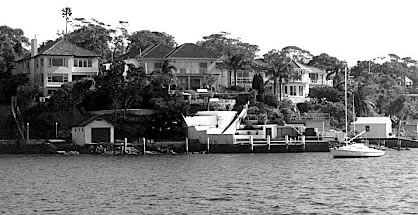 |
The code ought take cognisance of the fact that waterborne recreational activities are often associated with land based facilities. The extent and nature of on-shore infrastructure development is a partial determinant of the extent and nature of pressures on the waterway. The Foreshore Development Code ought address on-shore facilities as a partial means of controlling the growing pressures upon the Port.
The Port Hacking Foreshore Development Code ought provide an absolute protection against any further deterioration in the water quality of Port Hacking, and ought set its goal as being the re-establishment of the pure water quality of Port Hacking. |
| top of page |
|



